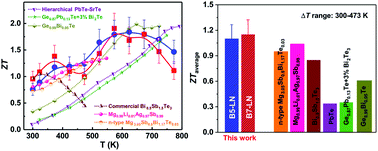Discovery of low-temperature GeTe-based thermoelectric alloys with high performance competing with Bi2Te3†
Abstract
Much effort has recently been put into developing high-performance low-temperature thermoelectric materials for waste-heat recovery and thermoelectric cooling. Here, we report an unusual enhancement of low-temperature figure of merit (ZT) in quenched p-type GeTe-based alloys. The average ZT within the low-temperature range (300–473 K) for the as-synthesized quenched GeTe-based alloys can reach 1.1, which is even better than that of the state-of-the-art commercial Bi0.5Sb1.5Te3 ingots. Moreover, the as-synthesized samples also show superior thermoelectric performance in the mid-temperature range, demonstrating great promise for thermoelectric applications in a broad temperature range. The Ge-vacancy arrays can serve as high-speed channels with low effective mass for carrier transport but obstacles for phonon transport, resulting in increased carrier mobility and reduced lattice thermal conductivity simultaneously for high ZT in the as-synthesized quenched GeTe-based alloys. These findings provide an intriguing way to enhance ZT and to develop low-temperature thermoelectric materials beyond Bi2Te3-based alloys.



 Please wait while we load your content...
Please wait while we load your content...